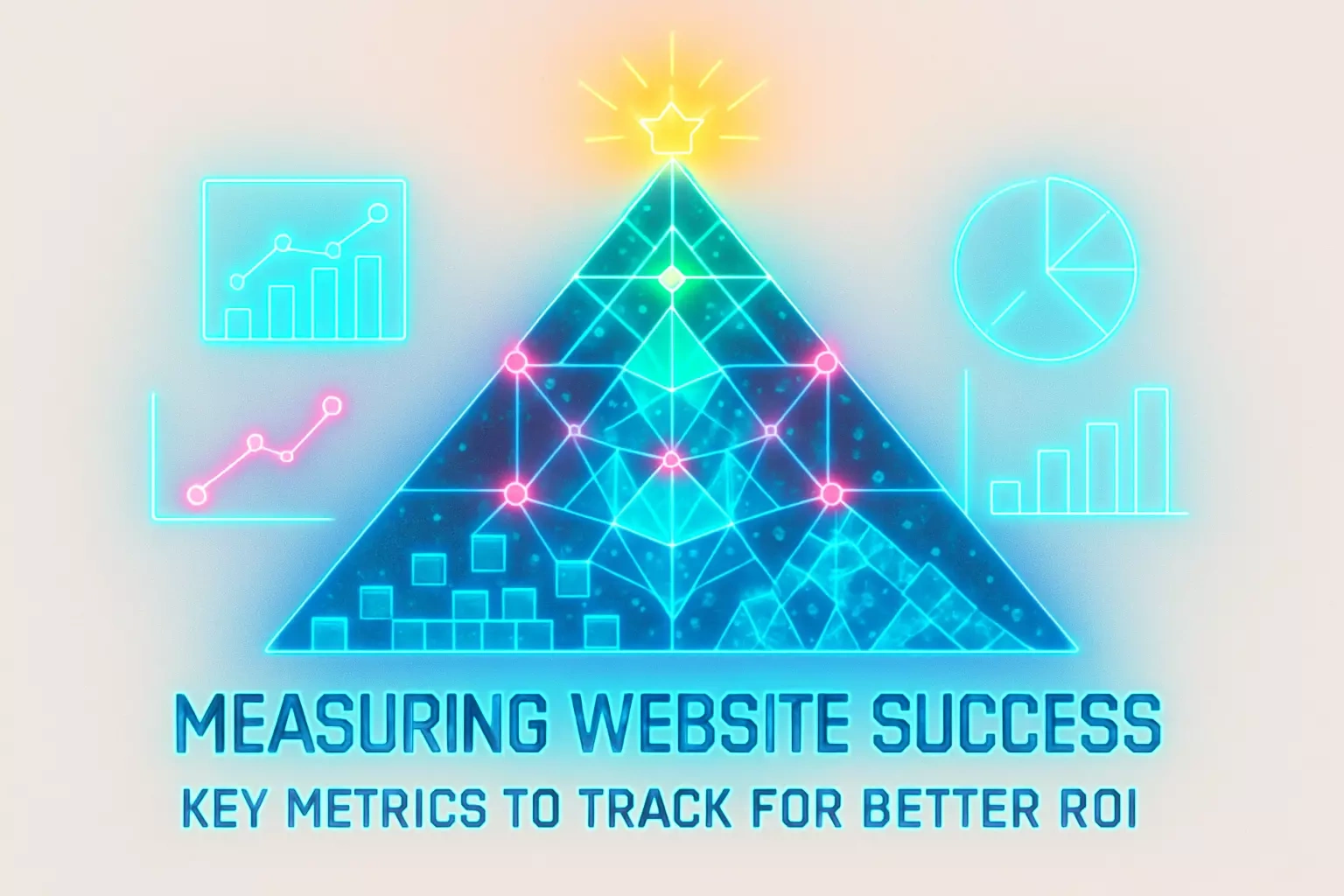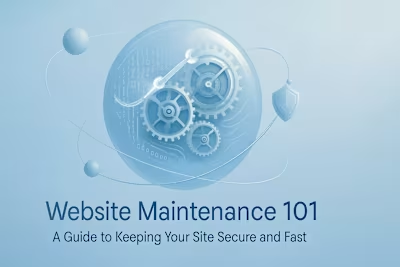Measuring Website Success: Key Metrics to Track for Better ROI

Measuring Website Success: Key Metrics to Track for Better ROI
Setting the Stage: Essential Tools for Website Analytics
Google Analytics 4 (GA4)
Google Search Console
Heatmap and User Recording Tools
Key Metrics for Measuring Website Performance
Traffic and Acquisition Metrics
Engagement Metrics
Conversion Metrics
User Experience and Technical Metrics
Analyzing Data and Turning Insights into Action
Identify Your Top-Performing Content
Analyze the User Journey
Set Benchmarks and Report Regularly
Conclusion
References
Measuring Website Success: Key Metrics to Track for Better ROI
A beautiful, well-maintained website is a great start, but its true value lies in its ability to achieve your business goals. Measuring your website's performance is not just about counting visitors; it's about understanding user behavior and its impact on your bottom line. By tracking the right metrics, you can make data-driven decisions to optimize your site and maximize its return on investment (ROI). Whether you're looking to hire a data-driven web designer or manage your site yourself, understanding these metrics is essential.
After mastering website maintenance, this is the crucial next step to understanding its value, before you ever have to consider when to redesign. Let's dive into the metrics that really matter and how to use them to grow your business.
Setting the Stage: Essential Tools for Website Analytics
Before you can measure anything, you need the right tools in place. These platforms are the foundation for gathering the data you need to evaluate your site's performance.
Think of analytics tools like the dashboard in your car. You wouldn't drive without knowing your speed or fuel level, right? The same goes for your website. Without proper tracking, you're essentially flying blind.
Google Analytics 4 (GA4)
This is the industry-standard free tool for tracking website traffic and user behavior. GA4's event-driven model provides detailed insights into how users interact with your site, from page views to form submissions.
What makes GA4 special is its focus on events rather than just pageviews. Every click, scroll, and interaction can be tracked as an event. This gives you a complete picture of how people actually use your site.
Setting up GA4 is straightforward. You'll need to add a tracking code to your website, which takes about 10 minutes. Once installed, GA4 starts collecting data immediately. You'll see information about your visitors, what pages they view, and how long they stay.
The real power comes from custom events. Want to know how many people click your "Contact Us" button? Set up an event. Curious about video engagement? Track that too. GA4 lets you measure what matters most to your business.
Google Search Console
This free tool from Google offers insights into your site's organic search performance. It shows you which keywords people use to find your site, your click-through rates, and any technical SEO issues Google has detected.
Search Console is like having a direct line to Google. It tells you exactly how Google sees your website. You'll discover which search terms bring people to your site and which pages rank best.
The tool also alerts you to problems. Maybe your site has broken links or pages that load too slowly. Search Console flags these issues so you can fix them quickly. This keeps your site healthy and ranking well.
One of my favorite features is the performance report. It shows your average position for different keywords over time. You can see if your SEO efforts are working or if you need to adjust your strategy.
Heatmap and User Recording Tools
Tools like Hotjar or Clarity provide visual data on where users click, scroll, and move their mouse. This qualitative data is invaluable for understanding user experience and identifying points of friction.
Imagine watching over someone's shoulder as they use your website. That's essentially what these tools do. You can see exactly where people get confused or frustrated.
Heatmaps show you the hot spots on your pages. Red areas get lots of clicks, while blue areas are ignored. This visual data often reveals surprising patterns. Maybe your main call-to-action button is being overlooked, or users are clicking on things that aren't even links.
Session recordings take this a step further. You can watch actual user sessions to see how people navigate your site. It's eye-opening to see someone struggle with something you thought was obvious. These insights lead to simple fixes that can dramatically improve user experience.
Key Metrics for Measuring Website Performance
Don't get lost in a sea of data. Focus on these key performance indicators (KPIs) to get a clear picture of how your website is contributing to your business goals.
The trick is knowing which numbers actually matter. It's easy to get excited about vanity metrics that look good but don't impact your bottom line. Let's focus on the metrics that drive real business results.
Traffic and Acquisition Metrics
Understand where your visitors are coming from. Track overall Users and Sessions, and analyze the Traffic Acquisition report in GA4 to see the breakdown of channels (e.g., Organic Search, Direct, Social, Referral).
Users tells you how many individual people visited your site. Sessions shows total visits, including repeat visitors. If you have 1,000 users and 1,500 sessions, that means people are coming back - a good sign!
The acquisition report is where things get interesting. It breaks down your traffic sources:
Organic Search: People who found you through Google or other search engines
Direct: Visitors who typed your URL directly or used a bookmark
Social: Traffic from social media platforms
Referral: Visitors from other websites linking to you
Each channel tells a different story. High organic traffic means your SEO is working. Lots of direct traffic suggests strong brand awareness. By understanding these sources, you can double down on what works and fix what doesn't.
Engagement Metrics
Measure how users interact with your site. Key metrics in GA4 include Engaged Sessions (visits that last longer than 10 seconds, have a conversion, or have at least 2 pageviews) and Average Engagement Time.
Engaged sessions are GA4's way of filtering out bounce traffic. Not every visitor who leaves quickly is uninterested - sometimes they found exactly what they needed right away. But generally, engaged sessions indicate quality visits.
Average Engagement Time replaced the old "time on site" metric. It's more accurate because it only counts active time when the browser tab is in focus. If someone spends 3 minutes actively reading your content, that's much more valuable than someone who left a tab open for an hour while making coffee.
Look for patterns in your engagement metrics. Which pages keep people reading? Which ones cause them to leave immediately? This data helps you understand what content resonates with your audience.
Conversion Metrics
This is where you measure ROI. Track Goal Completions (e.g., form submissions, downloads) and Conversion Rate (the percentage of users who complete a goal). For e-commerce sites, track transactions, revenue, and average order value.
Conversions are the actions that directly impact your business. They might be:
Newsletter signups
Contact form submissions
Product purchases
Document downloads
Account registrations
Your conversion rate is the percentage of visitors who complete these actions. If 100 people visit and 3 sign up for your newsletter, that's a 3% conversion rate. Industry averages vary, but 2-3% is typical for many goals.
For e-commerce sites, dive deeper into purchase behavior. Track your average order value to see if customers are buying more over time. Monitor cart abandonment rates to identify checkout problems. These metrics directly tie to revenue, making them crucial for ROI calculations.
User Experience and Technical Metrics
Monitor metrics that indicate user satisfaction and site health. Check your Page Load Speed using Google PageSpeed Insights and track your top Landing Pages to see where users first enter your site.
Page speed affects everything. Slow sites frustrate users and hurt search rankings. Google considers a load time under 3 seconds as good. Every second of delay can reduce conversions by 7%.
Use tools like Google PageSpeed Insights to get specific recommendations. Common issues include:
Large image files that need compression
Too many plugins or scripts
Slow server response times
Render-blocking JavaScript
Your top landing pages reveal which content attracts visitors. These pages are crucial because they create first impressions. If your blog post about "10 Marketing Tips" is a top landing page, make sure it's optimized and links to relevant services or products.
Analyzing Data and Turning Insights into Action
Collecting data is just the first step. The real power comes from analyzing it to find opportunities for improvement and then acting on those insights.
Data without action is just numbers on a screen. The goal is to find patterns, test improvements, and measure results. This creates a cycle of continuous improvement that drives real business growth.
Identify Your Top-Performing Content
Use the 'Pages and screens' report in GA4 to see which pages get the most traffic and engagement. This tells you what content resonates with your audience, so you can create more of it.
Start by sorting your pages by views and engagement time. Your top performers usually fall into a few categories:
Problem-solving content that answers specific questions
Resource pages with tools or downloads
Popular products or services
Viral or shareable content
Once you identify winners, ask why they work. Is it the topic? The format? The depth of information? Use these insights to guide future content creation.
Don't ignore your worst performers either. Low-traffic pages might need better titles, more promotion, or complete rewrites. Sometimes a small tweak can turn a dud into a star.
Analyze the User Journey
Use GA4's Path Analysis or Behavior Flow reports to understand how users navigate through your site. Identify common drop-off points to see where you can improve the user experience.
The user journey rarely follows the path you expect. People might land on a blog post, jump to your about page, then check pricing before contacting you. Understanding these paths helps you optimize the flow.
Look for common patterns:
Where do most journeys begin?
What's the typical path to conversion?
Where do people get stuck or leave?
Drop-off points are especially valuable. If 50% of users leave after viewing your pricing page, maybe your prices need better context or your value proposition isn't clear. If people abandon forms halfway through, perhaps you're asking for too much information.
Create user flows that guide visitors naturally toward conversion. Add clear calls-to-action at decision points. Remove obstacles that cause friction. Small improvements in the user journey can lead to big gains in conversions.
Set Benchmarks and Report Regularly
Establish baseline metrics and create a regular reporting schedule (e.g., monthly) to track progress over time. This helps you demonstrate the value of your website and identify trends early.
Start by documenting your current metrics. This becomes your baseline for measuring improvement. Include:
Monthly traffic numbers
Conversion rates for each goal
Average engagement metrics
Revenue or lead generation numbers
Create a simple dashboard that tracks these metrics over time. Many businesses find monthly reporting works well, but adjust based on your needs. High-traffic sites might benefit from weekly check-ins.
Your reports should tell a story. Don't just list numbers - explain what changed and why. Did traffic spike after a new blog post? Did conversions improve after simplifying a form? These insights help stakeholders understand your website's value.
Set realistic goals based on your benchmarks. Maybe you want to increase organic traffic by 20% over six months. Or improve your conversion rate from 2% to 2.5%. Specific, measurable goals keep everyone focused and accountable.
Remember to celebrate wins and learn from setbacks. A sudden traffic drop might reveal a technical issue. A conversion rate improvement validates your optimization efforts. Regular reporting keeps you proactive rather than reactive.
Conclusion
Measuring website success isn't about tracking every possible metric. It's about focusing on the numbers that matter to your business goals. Start with the basics - set up GA4 and Search Console if you haven't already. Choose 3-5 key metrics that align with your objectives.
Remember, data is only valuable when it drives action. Review your metrics regularly, test improvements, and measure the results. This cycle of measurement and optimization is what separates successful websites from digital brochures.
Your website should be a growing asset that contributes to your bottom line. By tracking the right metrics and acting on insights, you'll maximize your ROI and build a website that truly serves your business goals. Start measuring today, and let data guide your path to online success.
References
Like this project
Posted Jun 30, 2025
Is your website actually working? Learn how to measure its performance using key metrics and tools like Google Analytics to understand your traffic, engagement, and ROI.











